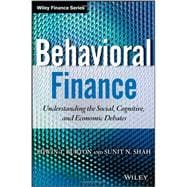
Note: Supplemental materials are not guaranteed with Rental or Used book purchases.
Purchase Benefits
What is included with this book?
EDWIN T. BURTON is a Professor of Economics at the University of Virginia, where he has taught behavioral finance to more than 1,800 students in the past six years. He is an active investment consultant for pension funds and endowments and is a Trustee of the Virginia Retirement System. Burton's Wall Street history includes senior positions at Smith Barney, Rothschild Inc., and Interstate/Johnson Lane. He has been an economics professor since 1969 including eleven years on the faculty at Cornell University. Burton currently serves on two public company boards (SL Green Realty Corporation and Virginia National Bank) and numerous private company boards. He first joined the faculty at the University of Virginia in 1988. Burton received his doctorate from Northwestern University in economics and his undergraduate degree in economics from Rice University.
SUNIT N. SHAH's experience in finance includes seven years of financial modeling for Life Settlement Consulting and Management, a position at Stanfield Capital Partners modeling movements of credit spreads, and corporate finance analysis at the Boston Consulting Group for a billion-dollar household products company. Prior work also includes founder's roles in both a dot com and a financial start-up as well as consulting for firms such as Investure, LLC and the CFA Institute. Over the past ten years, Shah has taught a number of introductory, intermediate, and advanced undergraduate economics courses in microeconomics, statistics, and finance. Shah received his doctorate in economics as well as his bachelor's in mathematics and economics from the University of Virginia.
Introduction
Part I: Introduction to Behavioral Finance
Chapter 1: What is the Efficient Market Hypothesis?
Information and the Efficient Market Hypothesis
Random Walk, the Martingale Hypothesis, and the EMH
False Evidence against the EMH
What Does It Mean to Disagree with EMH?
Chapter 2: The EMH and the "Market Model"
Risk and Return—the Simplest View
The Capital Asset Pricing Model (CAPM)
So, What is the Market Model?
Chapter 3: The Forerunners to Behavioral Finance
The Folklore of Wall Street Traders
The Birth of Value Investing: Graham and Dodd
Financial News in a World of Ubiquitous Television and Internet
Part II: Noise Traders
Chapter 4: Noise Traders and the Law of One Price
The Law of One Price and the Case of Fungibility
Noise
Chapter 5: The Shleifer Model of Noise Trading
The Key Components of the Shleifer Model
The Assets
Results
Why the Shleifer Model is Important
Resolving the Limits to Arbitrage Dispute
Chapter 6: Noise Trading Feedback Models
The Hirshleifer Model
The Subrahmanyam-Titman Model
Conclusion
Chapter 7: Noise Traders as Technical Traders
Technical Traders as Noise Traders
Herd Instinct Models
Conclusion
Part III: Anomalies
Chapter 8: The Rational Man
Consumer Choice with Certainty
Consumer Choice with Uncertainty
The Allais Paradox
Conclusion
Chapter 9: Prospect Theory
The Reference Point
The S-Curve
Loss Aversion
Prospect Theory in Practice
Drawbacks of Prospect Theory
Conclusion
Chapter 10: Perception Biases
Saliency
Framing
Anchoring
Sunk Cost Bias
Conclusion
Chapter 11: Inertial Effects
Endowment Effect
Status Quo Effect
Disposition Effect
Conclusion
Chapter 12: Causality and Statistics
Representativeness
Conjunction Fallacy
Reading into Randomness
Small Sample Bias
Probability Neglect
Conclusion
Chapter 13: Illusions
Illusion of Talent
Illusion of Skill
Illusion of Superiority
Illusion of Validity
Conclusion
Part IV: Serial Correlation
Chapter 14: Predictability of Stock Prices: Fama-French Leads the Way
Testing the Capital Asset Pricing Model
A Plug for Value Investing
Mean Reversion – The DeBondt-Thaler Research
Why Fama-French is a Milestone for Behavioral Finance
Chapter 15: Fama French and Mean Reversion: Which Is It?
The Month of January
Is This Just About Price?
The Over-reaction Theme
Lakonishok, Shleifer and Vishny (1994) on Value Versus Growth
Is Over-reaction Nothing More Than a ‘Small Stock’ Effect?
Daniel and Titman on Unpriced Risk in Fama and French
Summing Up the Contrarian Debate
Chapter 16: Short Term Momentum
Price and Earnings Momentum
Earnings Momentum – Ball and Brown
Measuring Earnings Surprises
Why Does It Matter Whether Momentum is Price or Earnings Based?
Hedge Funds and Momentum Strategies
Pricing or Earnings Momentum – Are They Real and Do They Matter?
Chapter 17: Calendar Effects
January Effects
The Other January Effect
The Weekend Effect
Pre-Holiday Effects
Sullivan, Timmermann, and White
Conclusion
Part V: Other Topics
Chapter 18: The Equity Premium Puzzle
Mehra and Prescott (1985)
What about Loss Aversion?
Could This Be Survivor Bias?
Other Explanations
Are Equities Always the Best Portfolio for the Long Run?
Is The Equity Premium Resolved?
Chapter 19: Liquidity
A Securities Market is a Bid-Ask Market
Measuring Liquidity
Is Liquidity a Priced Risk for Common Stocks?
Significance of Liquidity Research
Chapter 20: Neuro-Economics
Capuchin Monkeys
Innateness Versus Culture
Decisions Are Made by the Brain
Decisions versus Outcomes
Neural-Economic Modeling
More Complicated Models of Brain Activity
The Kagan Critique
Conclusion
Chapter 21: Experimental Economics
Bubble Experiments
Endowment Effect and Status Quo Bias
Calendar Effects
Conclusion
Conclusion: And The Winner Is?
The Semi-Strong Hypothesis – Prices Accurately Summarize All Known Public Information
Can Prices Change if Information Doesn’t Change?
Is the Law of One Price Valid?
Three Research Agendas
The Critics Hold the High Ground
What Have We Learned?
Where Do We Go From Here? (What Have We Not Learned?)
A Final Thought
Index
The New copy of this book will include any supplemental materials advertised. Please check the title of the book to determine if it should include any access cards, study guides, lab manuals, CDs, etc.
The Used, Rental and eBook copies of this book are not guaranteed to include any supplemental materials. Typically, only the book itself is included. This is true even if the title states it includes any access cards, study guides, lab manuals, CDs, etc.